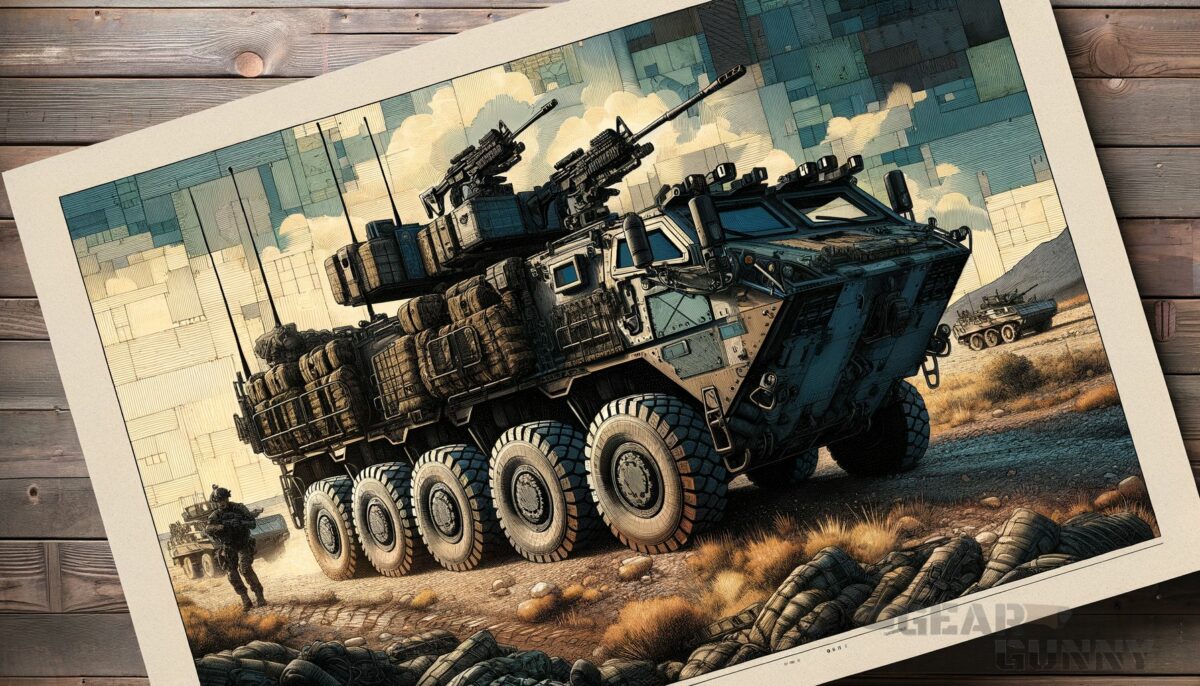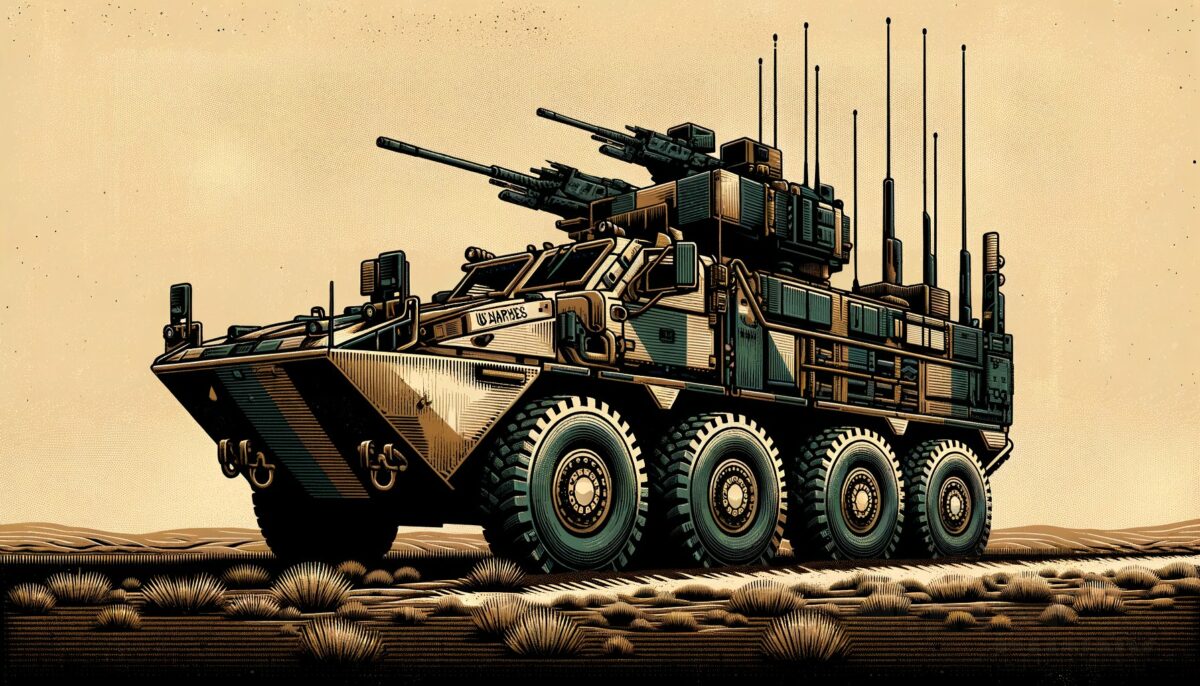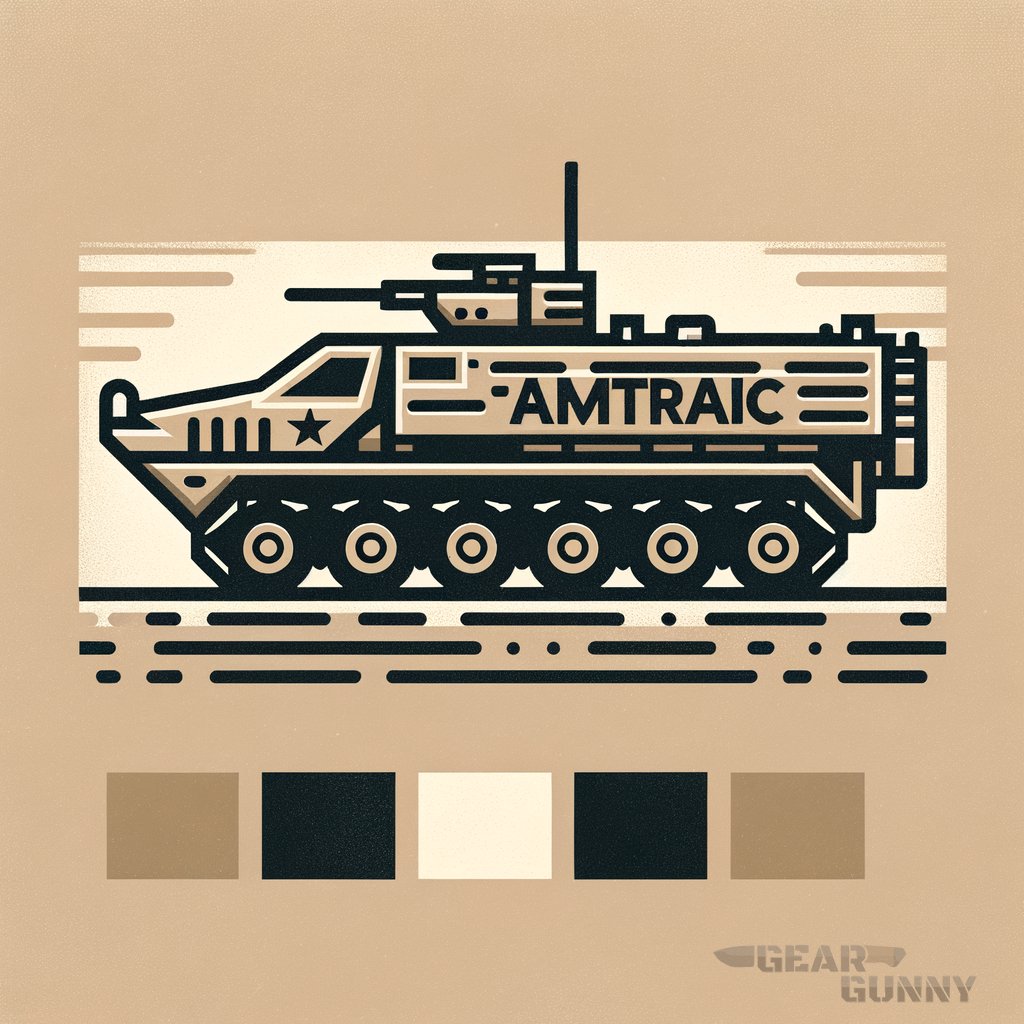Ever wondered what powers through land and sea, delivering Marines to the doorstep of the action? The AMTRAC, or Assault Amphibious Vehicle, has been just that workhorse. How might a battle-tested plate carrier play its part in such complex operations?
Here’s a dive into this amphibious marvel, and you’ll see just how it fits into the tactical equation.
Key takeaways
- The AMTRAC is a robust amphibious armored personnel carrier vital to marine assault operations.
- Upgrades and maintenance are crucial for keeping AMTRACs operational.
- Tactical proficiency in AMTRAC operations is key for mission success.
What is an AMTRAC
The AMTRAC, formally known as the Assault Amphibious Vehicle (AAV), is the workhorse of the Marine Corps’ amphibious assault forces. These robust machines are designed to ferry troops from ships to shore and beyond, braving both water and terra firma. Their inception dates back to 1972 and they’ve seen action from the Falklands War to operations in Iraq.

Here’s the rundown on some key specs that make AMTRACs vital:
- Amphibious capabilities: They can transition from sea to land without a hitch, making them indispensable in amphibious assaults.
- Armament: Packed with a Mk 19 grenade launcher and a .50 cal machine gun, these bad boys can hold their own in a firefight.
- Carrying capacity: Beyond their crew, they lug a full squad of 21 Marines, decked out in battlefield regalia, from the heavy-duty best tactical boots on their feet to the combat gear on their backs.
AMTRACs aren’t just floating tanks; they’re life-saving vehicles designed to get Marines where they need to be. The Marine Corps depends on them for their operational flexibility – a unique combo of firepower, protection, and mobility.

It’s my personal take, from someone who’s chewed the same dirt, that the AMTRAC is more than a vehicle; it’s a symbol of commitment. When you see that steel beast churning through the surf, you know the Marines are all in. It’s that steadfast presence that’s been integral to countless operations.
Of course, as a tactical gear enthusiast, I also appreciate the gear that complements such vehicles, like high-quality tactical gloves that enhance grip and protect hands when operating the weaponry these vehicles bear. It’s the synergy between man, machine, and gear that makes the USMC the formidable force it is.
5.11 Rush 24 Tactical Backpack

5.11 Rush 24 Tactical Backpack
Assault amphibious vehicles in a nutshell
If there’s one rig that showcases the might and adaptability of the USMC, it’s the Assault Amphibious Vehicle, commonly known as the AMTRAC. Diving into the piscine depths or crunching over unforgiving terrain, these behemoths ensure that Marines make landfall ready for action.
- Role and design: At its core, an AMTRAC is an amphibious armored personnel carrier. It provides the muscle to project power ashore, delivering devil dogs from the relative safety of assault ships onto hostile beaches.
- Usage and versatility: These titans are not just used by the USMC, but by various armed forces globally. Their primary mission is to ensure the swift deployment of Marines, their gear from robust best plate carriers to reliable sidearms, and everything needed to maintain combat effectiveness.
Tactical specifications of AMTRACs
Specs that make the AMTRAC formidable come down to a blend of firepower, protection, and payload.

The AMTRAC is more than a vehicle; it’s a marine force multiplier, a steel chariot that exemplifies the adaptability and strength of the USMC. Engaging in regular training exercises with these machines ensures that skills are honed for the moment they’re needed most – when the sea meets the sand in the theater of conflict.
- Armament details: These units pack a wallop with their Mk 19 grenade launchers and M2HB machine guns; the sort of firepower that demands respect on the battlefield.
- Protective features: It’s not just about offense with AMTRACs; they’ve got armor thick enough to shrug off enemy fire while keeping their precious cargo – our cherished Marines – shielded from harm.
Contribution to historical missions
From the sands of the Middle East to the rocky shores of the Falklands, AMTRACs have rolled, floated, and fought their way through multiple conflicts.
- Wars witnessed: The AMTRAC has a service record with chapters in the Falklands War, the Invasion of Grenada, and the Iraq War, among others.
- Tales of combat: In each conflict, these tracked leviathans have proven indispensable, sometimes sustaining damage, but always getting Marines to the fight.
Upgrades and enhancements
If there’s one thing the Corps knows, it’s that staying static is not an option. Just like a Marine’s gear, from their tactical gloves that evolve with field demands, AMTRACs have seen significant upgrades over their service lives.
- SLEP and beyond: The vehicles underwent a major Service Life Extension Program (SLEP) to keep them in fighting trim, showing the same devotion to readiness and resilience as any Marine does to their personal equipment.
- Future steps and developments: Even as new platforms like the Amphibious Combat Vehicle (ACV) emerge, the legacy of the trustworthy AMTRAC continues, a symbol of the USMC’s unwavering advance.
Operators and global reach
Marines may call it ‘yurt,’ but for forces worldwide, the AMTRAC signifies the might of U.S. engineering and military ingenuity shared across borders.
- International partners: From the Mediterranean to the Pacific, allied nations operate their own fleets, relying on this gritty transporter’s ability to deliver troops into the heart of conflict zones.
- List of operators: The global tapestry of operators weaves through several continents, showcasing the AMTRAC’s versatility in differing terrains and operational doctrines.
Assault Amphibious Vehicle (AAV) data table
Before you lace up those tactical boots and head into the fray, take a look at the specifics of the Marine Corps’ ironclad marine. This table gives you the key specifications of the AAV, offering a snapshot of what makes this platform such a cornerstone of amphibious assault operations.
| Specification | Detail |
|---|---|
| Type | Amphibious Armored Personnel Carrier |
| Service History | 1972–present |
| Mass | 29.1 tons |
| Dimensions (L x W x H) | 7.94m x 3.27m x 3.26m |
| Crew | 3 (driver, commander, gunner) + 21 troops |
| Armor | Up to 45mm |
| Main Armament | Mk 19 Grenade Launcher, M2HB Machine Gun |
| Engine | Upgraded to Cummins VTA-903T, 525 hp |
| Operational Range | 480 km; 20 NM in water |
| Maximum Speed (Land/Water) | 72 km/h (land), 13.2 km/h (water) |
More assault amphibious vehicle tips
When it comes to maximizing the use and effectiveness of an Assault Amphibious Vehicle, there’s more to it than just hopping in and setting off. Here’s an arsenal of tips for operators or enthusiasts looking to broaden their knowledge on these tactical behemoths.
- Keep up with maintenance schedules to ensure the AMTRACs are combat-ready at all times.
- Regularly check the hull integrity to maintain the vehicle’s amphibious capabilities.
- Conduct drills for both land and water operations to keep crews sharp.
- Iterate emergency procedures for quick response during breaches or malfunctions.
- Familiarize the crew with the weapon systems and armor capabilities of the AMTRAC.
- Engage in cross-training with infantry units to align the tactics of mounted and dismounted units.
- Always have a meticulous navigation plan for both the aquatic and terrestrial phases of an operation.
AMTRAC operation dos and don’ts
When fielding AMTRACs, just as when selecting the right tactical belt, there are best practices and pitfalls to avoid. Keep these dos and don’ts in mind to navigate the challenges:
| Do | Don’t |
|---|---|
| Do perform pre-operation checks | Don’t neglect signs of wear and tear |
| Do familiarize with local terrain | Don’t underestimate water currents and tides |
| Do use proper communication protocol | Don’t ignore communication issues |
| Do follow safety measures for embarking and disembarking troops | Don’t rush operations compromising troop safety |
| Do engage in regular training exercises | Don’t let skills and tactics become rusty or outdated |

Advantages and disadvantages of using the AMTRAC
The AMTRAC is a testament to military engineering, providing a unique set of strengths to any amphibious operation. However, like any specialized equipment, it has its set of trade-offs that should be considered.
Advantages
- Exceptional amphibious capabilities, enabling a seamless transition from naval to ground operations.
- High troop capacity, capable of transporting an entire Marine squad and their gear.
- Equipped with substantial firepower for both offensive and defensive actions.
- Robust armor that offers significant protection against small arms fire and shrapnel.
Disadvantages
- Slower speeds in water compared to dedicated naval vessels.
- Larger and heavier than many contemporary military vehicles, which can limit maneuverability.
- Requires specialized training and maintenance that can be resource-intensive.
- Despite upgrades, may still be susceptible to advanced IEDs and anti-vehicle weaponry.
If you are a visual learner, check out this video titled ‘Milsim Loadout – Beginner’
Frequently asked questions (FAQ)
What advancements are being made for future amphibious vehicles?
The USMC is actively developing the Amphibious Combat Vehicle (ACV) to eventually replace the AMTRAC. These next-gen platforms are likely to boast improved speed, armor, and network-centric warfare capabilities, ensuring seamless operations with the Marine Air-Ground Task Force (MAGTF).
Can AMTRACs be airlifted by military transport aircraft?
Yes, AMTRACs can be transported by certain military cargo aircraft, such as the C-5 Galaxy and the C-17 Globemaster III, which are designed to carry heavy equipment. This provides the Marines with rapid deployment capabilities to hotspots around the globe.
How do AMTRAC crews train for their missions?
AMTRAC crews undergo intense and comprehensive training that covers a wide spectrum of operational scenarios, including amphibious landings, land navigation, weapons qualifications, and vehicle maintenance. This routine ensures crews are prepared for the complexities of real-world operations.
Final thoughts
As we wrap up this deep dive into the world of AMTRACs, it’s clear that these vehicles are more than just transport—they’re a critical component of the USMC’s amphibious assault capabilities. With their storied history and continued upgrades, they remain at the forefront of marine warfare, ensuring that Marines can fight and win battles both on land and at sea.
How do you see the evolution of amphibious warfare with the introduction of new vehicles like the ACV? Did I cover everything you wanted to know? Let me know in the comments section below I read and reply to every comment.
If you found this article helpful, share it with a friend, and check out my full blog for more tips and tricks on these tactical giants. Thanks for reading, and stay on target with your curiosity and tactical knowledge.
















